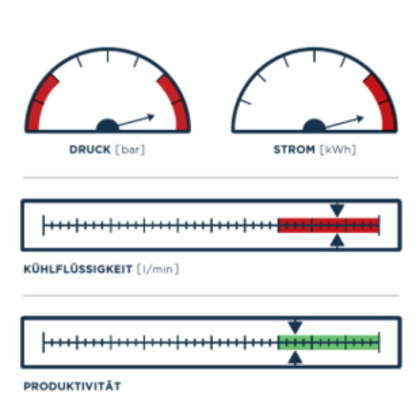Coolant Audit M3: Determining Lubricoolant Needs

Objective
Determining lubricoolant need in one or multiple machines
Description
This type of audit gives you accurate information about the lubricoolant consumption of your machine tool in terms of lubricoolant pressure, volume flow and exit speed.
We match the outcome of the audit to your questions regarding the design of lubricoolant filtration systems and lubricoolant system components such as pumps, valves etc.
Benefits to you
- Determining the correct
- > Lubricoolant pressure regimes
- < Lubricoolant volume flows
- Determining for
- > Lubricoolant components
- < Lubricoolant filtration systems
Scope of audit
- Determining of
- > Lubricoolant consumption profile
- Pressure and lubricoolant volume flow per (time/cycle/component)
- < Combined profile of all machines in operation
- Preparation of a pressure and lubricoolant volume supply plan for single or central supply
- Evaluation of volume-optimised pressure boosting (l/min)
- > Pressure boosting to single machines
- < Central pressure boosting
- Option of frequency-regulated pumps (central or local)
- Option of stationary pumps
- Offers for grindaix retrofit packages (nozzles, pumps, optimised settings)
Planen Sie Ihr Audit!
Gerne beraten wir Sie ausführlicher zu Ihrem gewünschten Thema. Füllen Sie einfach das unverbindliche Anfrageformular aus und wir setzen uns schnellstmöglich mit Ihnen in Verbindung.
Coolant Audit Maschinen
Our Machine Tool Audits
Our Filtration Audits
Procedure for a Coolant Audit M
1 Visit to your production environment
Our technicians visit you with all the necessary measurement equipment. Within a very short space of time (approx. 3h/machine), the periphery inside the machine is recorded.
2 Measurement of flow rates
By means of state-of-the-art measurement technology, we check the current lubricoolant flow rate per line. Depending on the audit, we also monitor all scenarios of your production process.
3 Recording supply pipes and fixtures
All pipes are completely recorded – from the lubricoolant supply connection to all nozzle exits. All geometrical and type values are also logged.
4 Analysis and evaluation of waste
We demonstrate how machining sites may be supplied in a robust way to meet the highest productivity demands, and how all waste in secondary zones may be avoided.
